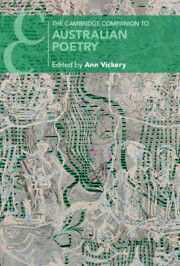Book contents
- The Cambridge Companion to Australian Poetry
- The Cambridge Companion to Australian Poetry
- Copyright page
- Contents
- Figures
- Contributors
- Acknowledgements
- Chronology
- Introduction
- Part I Change and Renewal
- Part II Networks
- 4 Above and Below
- 5 Romanticism, Sensibility, and Settler Women Poets
- 6 Experiment and Adaptation
- 7 The Post-war Golden Generation, 1945–1965
- 8 Generation of ’68 and a Culture of Revolution
- Part III Authors
- Part IV Embodied Poetics
- Part V Expanding Form
- Further Reading
- Index
- Cambridge Companions To …
- References
4 - Above and Below
Sublime and Gothic Relations in Nineteenth-Century Australian Poetry
from Part II - Networks
Published online by Cambridge University Press: aN Invalid Date NaN
- The Cambridge Companion to Australian Poetry
- The Cambridge Companion to Australian Poetry
- Copyright page
- Contents
- Figures
- Contributors
- Acknowledgements
- Chronology
- Introduction
- Part I Change and Renewal
- Part II Networks
- 4 Above and Below
- 5 Romanticism, Sensibility, and Settler Women Poets
- 6 Experiment and Adaptation
- 7 The Post-war Golden Generation, 1945–1965
- 8 Generation of ’68 and a Culture of Revolution
- Part III Authors
- Part IV Embodied Poetics
- Part V Expanding Form
- Further Reading
- Index
- Cambridge Companions To …
- References
Summary
This chapter considers how nineteenth-century poetry in Australia adapted European conceptualisations of the sublime and the gothic to articulate a literal inability to settle on the land. It argues that settler poetry has a difficulty with being grounded: its representations have a tendency to hover, sublimely, above the surface of the earth; or, if forced under, they refuse to simply die: but live on, as gothic, revenant, voices. It draws on popular and canonical examples like A. B. (Banjo) Paterson’s “The Man from Snowy River” and “Waltzing Matilda,” Adam Lindsay Gordon’s “The Sick Stockrider,” and Mary Gilmore’s “Old Botany Bay,” as well as examples that have been sourced from historical archives.
- Type
- Chapter
- Information
- The Cambridge Companion to Australian Poetry , pp. 73 - 88Publisher: Cambridge University PressPrint publication year: 2024



